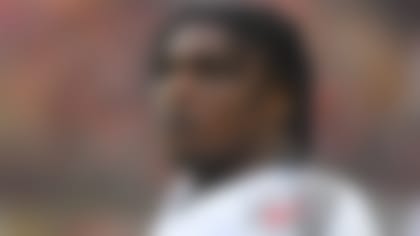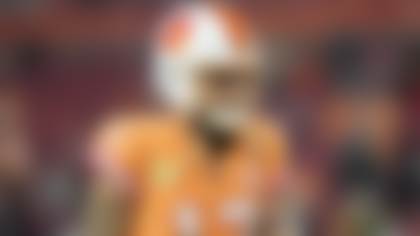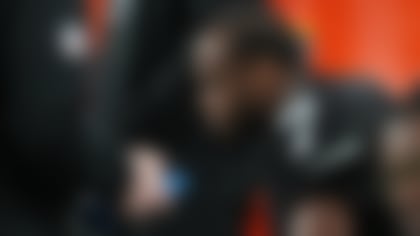When four-time Pro Bowl quarterback Jeff Garcia is training younger quarterbacks at the beginning of their gridiron experience, the intended target for a football starts quite large.
First, it should land between the receiver's waist and head. Then maybe the chest and head. After years of mechanical footwork, hip movement, arm-slot adjustments and timing exercises, it all leads to the gold standard: A 12-inch-by-12-inch moving target, one that travels with a receiver's stride or remains stationary with a static pass catcher.
"And at times, it goes to (six inches by six inches)," Garcia told me this week. "And at times, it goes to (two inches by two inches). That's what differentiates the greatness of some of these guys from the rest of the crew. I always was focused on that 12-inch-by-12-inch area, especially when you're working against air."
The gradual progression from wide target to small target that every quarterback goes through got us thinking about Kirk Cousins, who said last week that his No. 1 wide receiver in Washington -- the 5-foot-8 Jamison Crowder -- makes him a more accurate quarterback. His reasoning was based in Crowder's ball-tracking skills; the ability to essentially chase down anything near the intended catch-target point. But in examining the factors that impact quarterback accuracy -- and accuracy in general -- could aiming at a smaller target (person) in practice and in games, day after day, have a refined impact on people who already throw a football for a living? Does size of a receiver really matter at all?
According to NFL.com research, of the 10 most accurate quarterbacks in the NFL this season in terms of completion percentage, six play on teams that rank in the bottom third of the league when it comes to average receiver height. Excluding tight ends, the tallest of Cousins' top three targets is barely 6-foot (Pierre Garcon).
To better understand the aforementioned questions, and what it truly takes to be an accurate quarterback, NFL.com enlisted the help of a former star/current quarterback tutor (Garcia) and former Jets/Dolphins QB Chad Pennington, who currently owns the second-highest career completion percentage of all time among qualifying passers (66 percent over 89 games, or 2,471 attempts).
Like the position itself, the answer to being a truly accurate quarterback and the secrets behind it are quite complex.
"I think it's more a quarterback's ability to talk to his receiver with his ball placement," Pennington told me. "You see Peyton (Manning) do that a lot. Talk to the receiver, let him know what is around him by where you put the ball. Be able to put the ball in places where only your guy can get it."
* * * **
For Garcia, receiver size only made him a more "accurate" quarterback in one situation: tight coverage. For a quarterback who never thought about the real difference between some of his biggest targets (the 6-foot-3, 224-pound Terrell Owens) or his smallest (the 5-8 Brian Westbrook), the only difference was a slightly larger margin for error in that 12-by-12 window.
"Obviously, when you have a guy with length, you have the ability to put the ball in more areas. Or, at the least, your miss point is a little bit larger with a smaller guy," Garcia said. "But when you have an expectation of ultra-high accuracy, whether that receiver was 5-foot-7 or 6-foot-3, there wasn't a difference in how the ball was going to come out. Because one of the things I learned early in my life playing baseball is that you should never aim the ball.
"Once you start aiming the ball, now your accuracy is not going to be where it needs to be. Your inconsistency is going to show, and I feel like that is how I self-trained myself. Don't think about the size of players, think about areas on the field, so I can be the most accurate quarterback I can be."
The crux of Garcia's theory, that height and wingspan matter only when a defender is swarming your intended receiver, jibes with the ideology of at least one NFL team -- the Carolina Panthers -- who loaded themselves with bigger, wider targets to aid Cam Newton. The reigning MVP is reasonably accurate, but at times has the tendency to sail or force balls into tight coverage. The Panthers have the fourth-tallest receiver group in football (74.0 inches, on average) despite carrying the sub-6-foot Ted Ginn Jr. in the equation. Kelvin Benjamin (6-5, 245), Devin Funchess (6-4, 225) and Greg Olsen (6-5, 255) are all pretty hard to miss.
Pennington, whose best targets were the 5-11 Laveranues Coles, 5-10 Santana Moss and 5-10 Wayne Chrebet, saw his success with smaller receivers as more a reflection of their individual skills.
Pennington always considered himself a realist when it came to accuracy -- "I can't make the kind of throws that Aaron Rodgers makes -- that's not going to bode well for my success and I don't have his arm talent" -- but had an unspoken kinship with some of his best receivers that was hard to explain, which led to extremely efficient seasons.
Coles was short, but somehow "played bigger than his size," according to Pennington, and was able to create open space because of his physical nature. Pennington would rather Coles, who had two of his best three seasons with Pennington as his quarterback, get matchups in press coverage because he could beat up on defensive backs and widen the target area through sheer strength alone.
Chrebet weighed well under 200 pounds, but somehow had a bird's-eye view of the field during a game. He understood weaknesses and holes, especially in zone coverage, and was able to sit down in empty space.
Moss, who was more of a prototypical special teams player, somehow seemed smoother coming out of cuts, which, according to Pennington, "made it harder for defensive backs to cover him because there was no wasted motion."
"You tend to only see size when size is used correctly," Pennington said. "I've played with guys who never used their wingspan. I think what you do as a quarterback is that you look at each individual receiver and what makes them successful, then you build that information into your mental notebook when you're throwing to them to help them be more successful.
"Basically: When I throw him the football, does he give me a chance?"
* * * **
The fact that an unspoken language between a quarterback and his favorite wideout can negate size -- or perhaps make someone who is 5-8 like Crowder just as valuable statistically this year as Rob Gronkowski, Jimmy Graham or Michael Crabtree -- speaks to how incredibly different two players can see the same set of personnel. Or how differently they can react to new players.
Why is Lions quarterback Matthew Stafford on pace to have his highest completion percentage in his first season without Calvin Johnson? Why did Tom Brady enjoy a spectacular uptick in production with Wes Welker by his side in New England? Why is Cowboys rookie Dak Prescott, who boasts an impressive 66.8 percent completion rate, targeting the 5-8 Cole Beasley more than double the amount of times Tony Romo did during his last healthy season in Dallas?
"There's so many different things involved in the quarterback's decision making," Garcia said. "Timing, the mental side, the ability to co-exist and have a response from the physical side. To be able to be extremely accurate or set yourself apart, you have to be able to put all of those things together."
The answer always seems to come back to something bigger than football. Perhaps there is something intangible within Crowder that is just picked up on by Cousins. Because quarterbacks try not to aim, accuracy needs to be an almost unconscious reaction anyway.
When Pennington was with the Jets, he would see this manifested during games when both he and Coles would change a route on the fly without speaking to one another.
"We found ourselves on the same page more times than not," he said. "Even to the point where routes that were drawn up by our coaches may be manipulated just a bit because we understood what the defense was trying to get accomplished. An 18-yard in route may just turn into an 18-yard hook based on our mutual understanding on the fly.
"My trust in him was just off the charts. I could throw the ball in his area and know that nothing bad was going to happen -- and it might not even be a completion, just that we didn't push the ball down the field and get it intercepted. We just had a good feel for each other."
In those instances, height has nothing to do with it.










